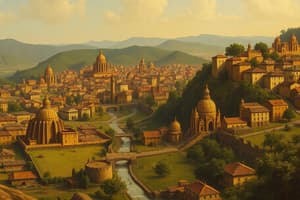Podcast
Questions and Answers
What time period did the Indus Valley Civilization exist?
What time period did the Indus Valley Civilization exist?
- 4000–2000 BCE
- 2500–700 BCE
- 3300–1300 BCE (correct)
- 1500–100 BCE
Which of the following cities was known for advanced urban planning and architecture?
Which of the following cities was known for advanced urban planning and architecture?
- Harappa
- Taxila
- Mohenjo-Daro (correct)
- Dholavira
What was one of the primary agricultural products of the Indus Valley Civilization?
What was one of the primary agricultural products of the Indus Valley Civilization?
- Wheat (correct)
- Sorghum
- Rice
- Millet
Which of the following statements is true regarding the writing system of the Indus Valley Civilization?
Which of the following statements is true regarding the writing system of the Indus Valley Civilization?
What type of economy was primarily practiced in the Indus Valley Civilization?
What type of economy was primarily practiced in the Indus Valley Civilization?
Which city in the Indus Valley Civilization is notable for its water conservation techniques?
Which city in the Indus Valley Civilization is notable for its water conservation techniques?
What factor contributed to the decline of the Indus Valley Civilization around 1300 BCE?
What factor contributed to the decline of the Indus Valley Civilization around 1300 BCE?
What evidence suggests ritualistic practices in the Indus Valley Civilization?
What evidence suggests ritualistic practices in the Indus Valley Civilization?
Which of the following best describes the cultural beliefs of the Indus Valley Civilization?
Which of the following best describes the cultural beliefs of the Indus Valley Civilization?
What legacy did the Indus Valley Civilization leave behind?
What legacy did the Indus Valley Civilization leave behind?
Flashcards are hidden until you start studying
Study Notes
Indus Valley Civilization
-
Time Period: Approximately 3300–1300 BCE.
-
Location: Northwestern region of South Asia, primarily in present-day Pakistan and northwest India.
-
Major Cities:
- Harappa: One of the two main urban centers.
- Mohenjo-Daro: Known for advanced urban planning and architecture.
- Dholavira: Notable for water conservation techniques.
-
Urban Planning:
- Highly organized cities with a grid layout.
- Advanced drainage systems and public baths.
- Use of standardized fired bricks for construction.
-
Economy:
- Agriculture: Primarily wheat, barley, and cotton cultivation.
- Trade: Engaged in trade with Mesopotamia and other regions.
- Craftsmanship: Skilled in bead-making, pottery, and metallurgy.
-
Writing System:
- Indus script: Undeciphered, consisting of symbols and signs.
- Limited inscriptions found on seals and pottery.
-
Religion and Culture:
- Polytheistic beliefs, possible worship of fertility deities.
- Figurines of women and animals suggest ritualistic practices.
- Artifacts include seals depicting animals and mythological figures.
-
Decline:
- Factors contributing to decline around 1300 BCE:
- Climate change leading to droughts.
- Possible shifts in river courses.
- Invasions or migrations of other tribes.
- Factors contributing to decline around 1300 BCE:
-
Legacy:
- Contributions to later Indian cultures.
- Influences seen in subsequent civilizations in the region.
-
Significance:
- One of the earliest urban civilizations in the world.
- Demonstrates advanced technological and social development for its time.
Indus Valley Civilization Overview
- Time Period: Approximately 3300–1300 BCE indicating a significant period of urban development.
- Location: Northwestern South Asia, chiefly in modern-day Pakistan and parts of northwest India.
Major Cities
- Harappa: One of the primary cities that played a central role in the civilization.
- Mohenjo-Daro: Renowned for its sophisticated urban layout and architectural innovations.
- Dholavira: Distinguished for its advanced water conservation methods, showcasing engineering excellence.
Urban Planning
- Cities designed with a grid layout, exhibiting foresight in urban development.
- Advanced drainage systems: Included drainage channels and public bathhouses, reflecting sanitation efforts.
- Standardized fired bricks: Utilized for construction, illustrating architectural uniformity and quality.
Economy
- Agriculture: Main crops included wheat, barley, and cotton, emphasizing agrarian sustainability.
- Trade networks: Engaged in commerce with Mesopotamia, highlighting economic interactions with distant regions.
- Craftsmanship: Renowned for skills in bead-making, pottery, and metallurgy, indicating a rich artisan culture.
Writing System
- Indus script: An undeciphered writing system featuring symbols and signs, primarily found on seals and pottery, hinting at a complex communication method.
Religion and Culture
- Polytheistic beliefs with a likelihood of fertility deity worship, suggesting societal values related to agriculture and reproduction.
- Figurines depicting women and animals imply ritualistic and cultural practices.
- Artistic artifacts, such as seals illustrated with animals and mythological figures, reveal a vibrant cultural life.
Decline
- Contributing factors for decline around 1300 BCE included:
- Climate change leading to prolonged droughts impacting agriculture.
- Possible alterations in river courses affecting water supply.
- Invasions or migrations by other tribes, suggesting external pressures on the civilization.
Legacy
- Indus Valley civilization's contributions are seen in later Indian cultures, indicating a lasting influence on subsequent civilizations in the region.
Significance
- Recognized as one of the earliest urban civilizations globally, showcasing remarkable technological and social advancements for its era.
Studying That Suits You
Use AI to generate personalized quizzes and flashcards to suit your learning preferences.




